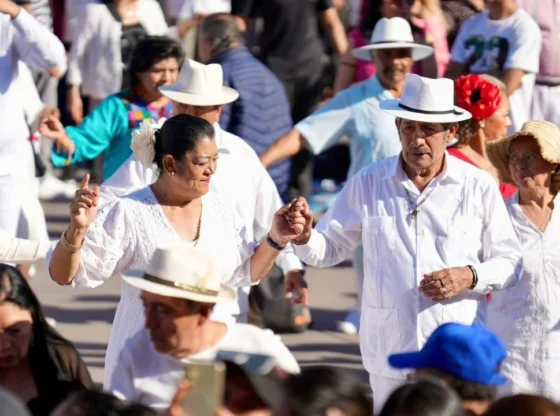Mexico City experienced a historic day with the Declaration of Danzón as Intangible Cultural Heritagea recognition that honors the communities, musicians, dancers and traditional halls that have kept this expression alive for more than a century. The announcement was made within the framework of the “Great Danzón Dance”, organized by the capital’s Government through the Ministry of Culture, which brought together thousands of people on the Zócalo plateau.
Key figures such as Clara Brugada MolinaHead of Government; Ana Francis MorSecretariat of Culture; Marcos Rodríguez CostaAmbassador of Cuba; and the legendary Cuban singer Omara Portuondowho was named Honorary Godmother of the Declaration. Representatives of emblematic salons such as Miguel Nieto from the Los Angeles Hall and Simon Jara from the Salón Colonia, as well as 200 musicians from 25 danzoneras, marking an unprecedented moment for this binational tradition.
You may also be interested in: 43 flannel vessels detained during Corona Capital 2025
Brugada stressed that danzón is more than a dance: It is a practice of civility, respect and community that has woven networks of affection in neighborhoods and squares.. “Today we officially recognize it as the living heritage of our people,” he stated, highlighting that this declaration will ensure its permanence in public spaces, schools and traditional classrooms.
For her part, the capital’s Secretary of Culture highlighted that this recognition was possible thanks to a technical file built together with the danzone community, documenting the cultural, social and identity values of danzón. “Danzón is not just music and dance, it is a way of inhabiting the city”, he expressed.
A festival of identity, memory and community in the Zócalo
The Zócalo was transformed into a large dance floor with the participation of groups such as the Failde Orchestra of Cuba, Acerina and her Danzoneraand the Danzonera La Playa de Veracruz. Thousands of couples celebrated between lilting steps and the unmistakable cinquillo, reaffirming the validity and community strength of the genre.
Finally, the capital government also recognized bearers of the tradition as María Guadalupe Cruz Gómez and Carlos Eduardo Vargas Medinaand assumed safeguarding commitments: support for danzoneras, workshops in PILARES and Casas de Cultura, and programs in public schools to bring this expression to new generations.
With this declaration, the danzón is consolidated as a symbol of shared identity between Mexico and Cubaa living heritage that continues to beat in every beat and in every community that embraces it.

